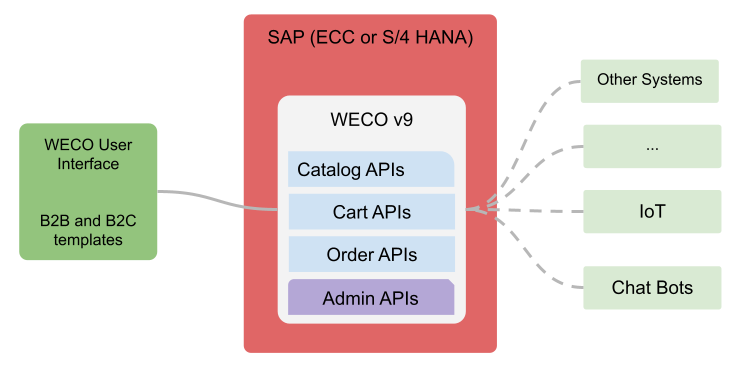The WECO team is hard at work to bring version 9.0 of the software later this year. As we wait for the release later this summer, I wanted to take the opportunity to share some of the new and exiting features that are on the roadmap. Over the next few blog posts I will share some of the features that are planned for this release.
In Part 1 of the series I will start with the biggest improvement - adding support for "headless" eCommerce scenarios. First a bit of background...
What is "headless" eCommerce
eCommerce platforms have a difficult task to balance 2 somewhat conflicting forces. On one side, they serve as a marketing tool to draw and keep customers engaged by providing polished, easy to navigate and, more importantly, a constantly evolving user experience. On the other side, they have to execute complex business rules like checking availability, pricing, discounts, shipping, providing right recommendations etc..
Keeping the site fresh is all about encouraging changes and experimentation, while keeping the site stable is all about minimizing changes (as any change can unintentionally break one of the many business rules that are needed for the proper ordering process).
WECO uses BSP (Business Server Pages) for building user facing web pages. Like many of its counterparts on other platforms, the BSP technology, unless done carefully, presents a risk of intermingling the code for the business rules that govern the page business logic with the presentation components (buttons, tables, sliders etc.). Any changes to the look and feel, could potentially cause unintended effects on the business logic (for example adding a new way to add/remove products to a shopping cart, needs to also properly trigger the appropriate business logic for recalculating pricing, discounts, shipping etc.). This dependency creates challenges for developers who are in charge of building the user experience as they have to carefully track what business rules are attached to what UI component and predict how they will be affected if the element is moved, removed or redesigned. This tracking and constant re-testing is one of the main culprits that slow down the rate at which Marketing departments can deliver on their vision.
“Headless” eCommerce architecture greatly reduces the dependency between the page “look & feel” and the page business logic by enforcing a clear separation between the two. The term “headless” means that the core of the eCommerce platform, (what implements the "business logic"), is so independent that is usable on its own, even without any user interface (or “head”).
What are the implications for the existing WECO customers
WECO will continue to fully support and enhance the BSP version going forward. The "headless" version will co-exist with the BSP version to provide the flexibility when needed. The overall WECO functionality and experience will remain mostly the same (with a several enhancements that I will share in Part 2 of this blog).
In addition to the standard WECO BSP modules that are currently available (e.g. B2B B2C etc.) WECO will release additional modules that can be used when customers prefer a headless solution:
- Headless Business Services module will offer a collection of eCommerce business rules exposed through a set of clear REST APIs (WECO 9 will offer more than 100 APIs for its various eCommerce functions).
- Headless User Interface module (e.g. B2B and B2C templates) will be delivered as a highly customizable, modern Progressive Web Application (developed using Angular.JS).

This is preliminary information and may change before the official WECO 9 release later this year
Working together, both modules will provide similar set of functionality as the existing BSP solution but in a more flexible and future-proof way. Customers, who opt for the "headless" solution will also gain several important benefits:
- Marketing teams can freely experiment with the appearance of the Web Store without worrying that these changes would cause huge delays in implementations (as look/feel changes will be cleanly separated from the business logic.)
- WECO's "headless" User Interface module is built using the industry standard Angular.JS Progressive Web Application (PWA) technology. This allows a large pool of web developers to make and enhance the look and feel on the Web Store using standard REST API calls that they are already familiar with. There is no need for them to know BSP, ABAP or even have SAP logins.
- Because the headless business services are not intermingled with the user facing pages, they can be easily reused in a variety of enterprise scenarios. For example Voice Applications, Chat Bots and IoT devices can interact with SAP eCommerce functionality in a secure and controlled manner (e.g. an IoT sensor can trigger a reorder of material using the same logic as if ordering via the web site.)
In part 2 of this series, I will cover some of the other features that are planned for v9 - Stay Tuned.


